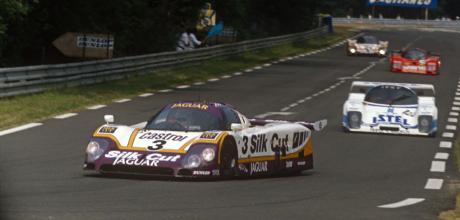Le Mans 1988
There was great excitement in the 1970s and 1980s when Jaguar re-entered international motorsport. It started with support of Bob Tullius’s Group 44 outfit in the States followed by Tom Walkinshaw’s TWR team originally in the European Touring Car Championship with the XJ-S and later Group C endurance racing. But thanks to its five victories in the Fifties, for Jaguar the most important race had always been the 24 Hours of Le Mans. By 1987 and with TWR starting to become genuinely competitive in the World Sports Car Championship we knew there was a real possibility of us winning for the first time since 1957.
Since I was already in France at the time of the race, working on the XJ41 prototype at a French engineering firm Hartman, located north of Paris, I decided to travel the short distance to Le Mans.
AFTER 1988 PEOPLE WERE ONCE AGAIN PROUD TO WORK FOR THE COMPANY
When I arrived, the goodwill and amount of interest in Jaguar from the French was astonishing and it felt like the country had adopted TWR’s white, purple and gold cars as its local team.
For over 12 hours and well into the early hours of the second day, Jaguar and Porsche constantly changed places, turning it into more of a sprint race. Unfortunately two of the three cars retired and only one managed to finish in fifth place. This meant the expectation for the 1988 event was even higher.
I once again travelled to Le Mans together with the tens of thousands of other Brits and the excitement throughout the 24 hours when Jaguar had a genuine chance of winning was palpable. The atmosphere and excitement after so many years of waiting when the winning XJR-9 crossed the line (pictured above) closely followed by its two sister cars in formation was indescribable.
The effect the 1988 victory had on the company, even for those who weren’t there, was astonishing. From Jaguar’s engineering centre at Whitley to the Browns Lanes assembly line, the win really did help raise morale. By the 1980s Jaguar had become something of a laughable cottage industry, living on the reputation of its past, but after 1988 people were once again proud to work for the company.
This was also the year we revealed the original XJ220 prototype at the British Motor Show in October. The car, together with the Le Mans victory, resulted in a powerful reimagining of Jaguar and it really did feel like the company had been reborn. Up until then, most of Jaguar’s folklore was 20 or 30 years old and since the Seventies had increasingly been seen as an ‘old man’s car’. But thanks to the victory together with the XJ220, this quickly changed; by the end of 1988 Jaguar would become a revitalised, progressive and desirable brand. Little wonder former engineering director, the late Jim Randle, described it as his best ever year.
It was partly because of the impact these two events had on Jaguar that it was deemed valuable enough to be bought by Ford the following year. Considering the company had almost gone under at the start of the decade, this was quite the turnaround.
And so the internal and external repercussions of that 1988 Le Mans victory went beyond just winning a motor race. It would come to define Jaguar in its immediate post-Leyland period.


